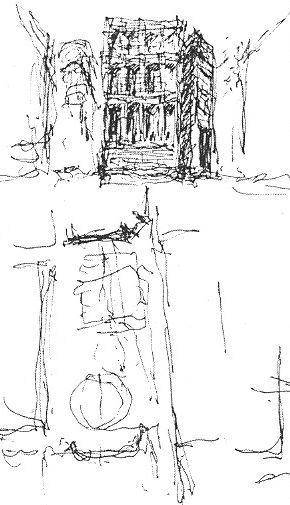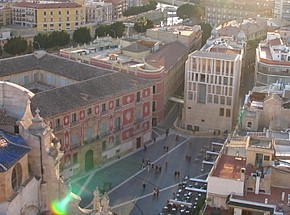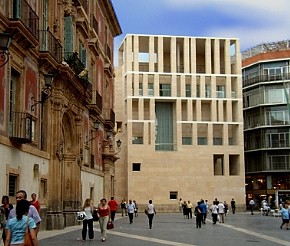2012.02.12 14:13
Murcia City Hall, Moneo and Pienza, perhaps?
The City Hall Annex as (Semperian) weaving (into) the urban fabric?
aside: Among other things, Minerva is the goddess of weaving, so what exactly is the Atrium Minerva doing within the garden of satire?
2012.02.12 12:23
Murcia City Hall, Moneo and Pienza, perhaps?
I dare ask, would you accept the same excuse from one of your students?
Here's a Moneo sketch:

| |
2012.02.12 12:00
Murcia City Hall, Moneo and Pienza, perhaps?

...for your comparison to be a success, you must present the whole of the Murcia piazza, and not just the City Hall by Moneo--just as you present the whole of the Pienza piazza above. The City Hall facade may relate somehow to the facade of the opposite Cathedral, as it already seems to be a (contextual) blend of the two buildings to either of its sides--the modern glass facade slipped behind the gridded pattern of the Palazzo.

A look through Camillo Sitte's The Art of Building Cities may also aid in fleshing out the comparison.
| |
2012.01.30 14:44
Narrative in architecture / landscape?
Ah yes, Rita Novel. What an apt name for such a paramount figure within the contemporary realm of narrative in architecture.
Regarding the Danteum, see how it fits within the overall sequential/narrative formula of the promenade architecturale: 3122z through to 3123l.
And there's Piranesi's Ichnographia Campus Martius--"While representing a reenacted plan of ancient Rome's Field of Mars, Piranesi ingeniously delineates two narratives--that of pagan Rome and that of Christian Rome--and at the same time offers an unprecedented lesson in urban design.
Within the Ichnographia Campus Martius there is the "Pagan - Christian Triumphal Way," which also fits within the sequential/narrative formula of the promenade architecturale noted above, and there is "Eros et Thanatos," starting at 2683 and going through to 2683l.
I'd also consider looking at John Hejduk's Adjusting Foundations--a somewhat more inscrutible narrative, but almost ceaselessly compelling nonetheless. It's a book I've yet to tire of "reading," although I rarely pay any attention to the words.
2012.01.29 20:08
25 Year AIA Award - and state of the Profession Part 2..?
Has the Gehry Residence made its neighborhood unsuccessful? I was there for maybe like 10 minutes sometime September 1982, so I really couldn't say whether the house made the neighborhood unsuccessful. Anyone who knows Santa Monica better, can you tell us whether the Gehry Residence has made the neighborhood unsuccessful.
2012.01.29 13:34
Looking for Venturi cartoon
It appears that Robert Miller's drawing/cartoon was first published within Denise Scott Brown's "Learning from Pop" in Casabella, December 1971. "Learning from Pop" was republished within A View from the Campidoglio: Selected Essays 1953-1984, where the drawing can be seen in its full extent--the cartoon above is only part of the original drawing.
If you go to read "Learning from Pop" (within A View from the Campidoglio), also read Framton's response and then Scott Brown's response to the response. Is this the seminal point of "white" versus "gray"?
| |
2012.01.29 11:39
Looking for Venturi cartoon
To further confuse the issue, see pages 56-58 of The Language of Post-Modern Architecture--interesting theory of movie star homes being "the most influential in popular taste."

For the record, the cartoon above from Learning from Las Vegas is from the "Learning from Levittown" studio at Yale 1970, with the drawing/cartoon by Robert Miller (who might be the inspiration for a fictional client today).
"Following the appearance of Learning from Las Vegas (1972), R. Venturi, D. Scott Brown and S. Izenour had planned the publication of their second Yale research project under the title "Learning from Levittown". This book was never completed, but the research material became the basis for a 1976 exhibition [Signs of Life] in Washington D.C." --Stanilaus von Moos
Eclectic Houses and the Gooding House are both from 1977, and may well be seen as "theory/research into practice." Check out the comparative scales.
And in 1999, hyper-eclectic...
|